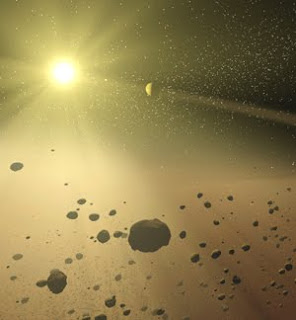Saturday, June 26, 2010
Asteroid Belt
The asteroid belt is the region of the Solar System located roughly between the orbits of the planets Mars and Jupiter. It is occupied by numerous irregularly shaped bodies called asteroids or minor planets. The asteroid belt region is also termed the main asteroid belt or main belt because there are other asteroids in the solar system such as near earth asteroids and trojan asteroids.
More than half the mass of the main belt is contained in the four largest objects: Ceres, 4 Vesta, 2 Pallas, and 10 Hygiea. These have mean diameters of more than 400 km, while Ceres, the main belt's only dwarf planet, is about 950 km in diameter.[1][2][3][4] The remaining bodies range down to the size of a dust particle. The asteroid material is so thinly distributed that multiple unmanned spacecraft have traversed it without incident. Nonetheless, collisions between large asteroids do occur, and these can form an asteroid family whose members have similar orbital characteristics and compositions. Collisions also produce a fine dust that forms a major component of the zodiacal light. Individual asteroids within the main belt are categorized by their spectra, with most falling into three basic groups: carbonaceous (C-type), silicate (S-type), and metal-rich (M-type).
The asteroid belt formed from the primordial solar nebula as a group of planetesimals, the smaller precursors of the planets. Between Mars and Jupiter, however, gravitational perturbations from the giant planet imbued the planetesimals with too much orbital energy for them to accrete into a planet. Collisions became too violent, and instead of sticking together, the planetesimals shattered. As a result, most of the main belt's mass has been lost since the formation of the Solar System. Some fragments can eventually find their way into the inner Solar System, leading to meteorite impacts with the inner planets. Asteroid orbits continue to be appreciably perturbed whenever their period of revolution about the Sun forms an orbital resonance with Jupiter. At these orbital distances, a Kirkwood gap occurs as they are swept into other orbits.
source:Wikipedia
Subscribe to:
Post Comments (Atom)

No comments:
Post a Comment